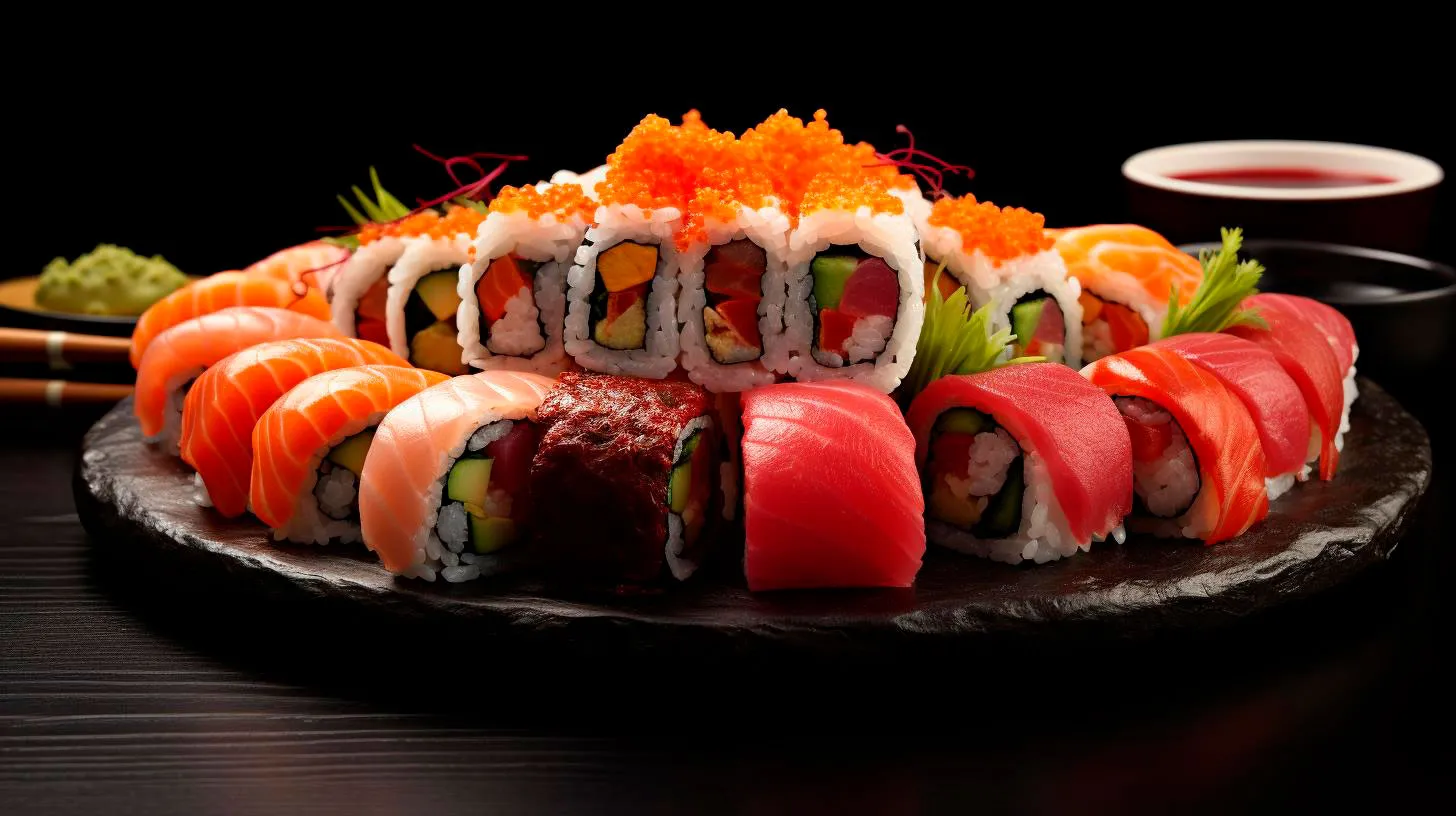Enchanting Little Taste Buds: Sushi as a Healthy Kids Delight
Let’s explore the enchanting world of sushi and understand why it can be an excellent choice for your little ones.
1. Sushi: A Nutritional Powerhouse
Sushi offers a plethora of health benefits for growing children:
- Rich in Omega-3 Fatty Acids: Sushi often includes fish like salmon and tuna, which are high in omega-3 fatty acids. These essential fats promote brain development and improve cognitive function.
- Packed with Protein: The combination of fish and rice in sushi provides a good amount of protein, which is crucial for children’s growth, muscle development, and tissue repair.
- Loaded with Vitamins and Minerals: Sushi usually contains various vegetables like avocado and cucumber, which offer essential vitamins and minerals. These nutrients are vital for strengthening the immune system and supporting overall well-being.
- Low in Saturated Fat: Unlike many processed kids’ meals, sushi is generally low in unhealthy saturated fats. Opting for sushi can help maintain a healthier diet for your children.
By introducing sushi to your child’s diet, you are providing them with a well-rounded meal that offers numerous health advantages.
2. Making Sushi Fun and Appealing to Kids
Adopting a creative approach can turn sushi into an exciting and enjoyable experience for your children. Here are some tips to make sushi more kid-friendly:
- Sushi Rolls: Children love finger foods, so making sushi rolls rather than nigiri (fish on rice) or sashimi (sliced raw fish) could be a great option. You can include their favorite ingredients like cucumber, carrot, and cooked shrimp to customize the rolls.
- Colorful Presentation: Use vibrant ingredients to make the sushi visually appealing. Kids are more likely to try something that looks enticing and fun.
- Get Them Involved: Let your kids participate in the sushi-making process. It can be a fantastic bonding activity, and they will be more excited to taste their creations.
- Japanese-inspired Side Dishes: Accompany the sushi rolls with traditional Japanese side dishes like miso soup or edamame. This way, your child can experience a complete Japanese meal.
Remember, the key is to make sushi a delightful and interactive experience for kids, encouraging them to explore new flavors in a playful manner.
3. Addressing Concerns and Safety Precautions
Although sushi is generally safe and nutritious for kids, it’s essential to consider a few factors:
- Quality and Freshness: Ensure you source sushi-grade fish from trusted suppliers to ensure it is fresh, safe, and free from harmful bacteria or parasites.
- Mercury Levels: While fish is an excellent source of nutrients, certain types can contain higher levels of mercury. Opt for low-mercury options such as salmon or cooked shrimp.
- Allergies: Take note of any seafood allergies your child may have and avoid those ingredients. There are plenty of vegetarian or cooked fish options available.
By being mindful of these concerns and taking necessary precautions, you can enjoy sushi as a delectable and healthy treat for your kids.
4. Key Takeaways: Why Sushi is a Healthy Kids Delight
Let’s summarize the main reasons why sushi can be a fantastic choice:
- Provides essential nutrients like omega-3 fatty acids, protein, vitamins, and minerals, supporting children’s healthy development.
- Low in unhealthy saturated fats, making it a healthier alternative to many kids’ meals.
- Can be made visually appealing and fun for kids by using colorful ingredients and involving them in the preparation process.
- Encourages adventurous eating by introducing unique flavors and ingredients.
- Offers a versatile eating experience with various sushi rolls and accompanying side dishes.
Now that you’re aware of sushi’s enchanting flavors and numerous health benefits, it’s time to excite your little one’s taste buds with this nutritious and delectable Japanese delight!
Exploring Flavors: Introducing Kids to the World of Sushi
In this article, we will dive into the world of sushi, discussing its flavors, health benefits, and how to introduce it to kids.
The Health Benefits of Sushi for Kids
Sushi offers numerous health benefits for children, making it a great addition to their diet. Here are some key advantages of incorporating sushi into your child’s meals:
- Rich in Omega-3 Fatty Acids: Fish such as salmon and tuna are common ingredients in sushi, providing a good source of omega-3 fatty acids. These essential fats are crucial for brain development and improving cognitive functions in kids.
- Packed with Protein: Sushi contains protein-rich ingredients like fish, tofu, and seafood. Protein is essential for the growth and development of children, aiding in building strong muscles, bones, and tissues.
- High in Vitamins and Minerals: Sushi incorporates various vegetables like avocado, cucumber, and carrots, which are abundant in vitamins and minerals. These nutrients contribute to improving children’s overall health and immune system.
- Low in Unhealthy Fats: Unlike many fast-food options, sushi is low in unhealthy fats, making it a healthier choice. By introducing sushi to kids, you encourage them to adopt a nutritious eating habit from an early age.
Exploring Sushi Flavors and Varieties
Sushi is incredibly diverse, with a wide range of flavors and textures to incorporate. Here are some popular sushi varieties you can introduce to your child:
1. Maki Rolls:
Maki rolls are a great starting point for kids. These sushi rolls are made with seaweed (nori), rice, and various fillings. Opt for milder flavors and ingredients such as cucumber, avocado, or cooked shrimp to make it more appealing to children.
2. Nigiri Sushi:
Nigiri sushi consists of small rice portions topped with slices of raw or cooked fish. Start with familiar fish like salmon or tuna and gradually introduce new flavors like eel or yellowtail.
3. California Rolls:
California rolls are typically made with crab or imitation crab meat, avocado, and cucumber. These rolls are often a hit with kids due to their mild flavors and familiar ingredients.
How to Introduce Sushi to Kids
When introducing sushi to children, it’s important to create a positive and enjoyable experience. Follow these tips to make the process smooth and exciting:
- Make it Interactive: Involve your child in the sushi-making process by letting them assemble their own rolls. Provide a variety of ingredients and let their creativity flow.
- Start with Familiar Ingredients: Begin with sushi rolls that include ingredients your child already enjoys. Gradually introduce new flavors, encouraging them to try out different combinations.
- Offer Condiments and Dipping Sauces: Provide soy sauce, wasabi, and pickled ginger on the side. Let your child experiment with these condiments to enhance the flavors according to their preferences.
- Create a Colorful Presentation: Sushi can be visually appealing to kids. Arrange the rolls in an attractive manner and use colorful toppings to make it more enticing.
- Be Patient and Supportive: Understand that it may take a few attempts before your child embraces sushi. Encourage them to try, but do not force or pressure them. Keep it a positive experience.
The Takeaway
Introducing children to the world of sushi opens up a whole new realm of flavors and encourages them to explore different cuisines. With its health benefits and wide variety of options, sushi can become an exciting and nutritious meal for kids. By following our tips and approaching it in an interactive and supportive way, you can make the sushi experience enjoyable for the whole family.
From Picky Eaters to Adventurous Diners: Sushi for the Young
However, with a little creativity and guidance, sushi can become a fun and nutritious meal for children of all ages.
As a parent, you might be wondering why you should bother introducing sushi to your child’s diet. Well, aside from being incredibly delicious, sushi offers a wide array of health benefits. This bite-sized dish typically includes a variety of ingredients such as fresh fish, seaweed, vegetables, and rice, making it packed with essential nutrients and vitamins. Additionally, sushi is low in saturated fat and high in omega-3 fatty acids, which are essential for brain development.
Creating a Kid-Friendly Sushi Experience
Introducing sushi to children isn’t just about the food itself, but also the experience. By making sushi eating a fun and interactive activity, children are more likely to become adventurous diners. Here are some tips and tricks to create an enjoyable and kid-friendly sushi experience:
- Start with familiar ingredients: Begin by including ingredients that your child already enjoys, such as avocado, cucumber, or cooked shrimp. This way, they will be more open to trying sushi when they recognize some familiar flavors.
- Make it bite-sized: Traditional sushi rolls can be quite large, making them difficult for small hands to handle. Instead, opt for bite-sized sushi rolls or even sushi sandwiches. These smaller portions are easier for children to manage and navigate.
- Get creative with shapes: Using different molds or cookie cutters, you can shape the sushi into fun and appealing figures like animals, stars, or even just basic shapes. This visual appeal will make it more enticing for your child to try sushi.
- Involve your child in the process: Let your child participate in the sushi-making process. Allow them to help with rolling the sushi or choosing their favorite ingredients. By involving them in the preparation, they will feel a sense of ownership and excitement towards the final result.
The Benefits of Sushi for Kids
Aside from being a tasty treat, sushi offers several key benefits for children:
- Encourages a diverse palate: Introducing sushi at a young age opens children up to a wide range of flavors and textures. This exposure can help cultivate a diverse palate and reduce picky eating habits.
- Boosts brain development: With its omega-3 fatty acids, sushi promotes healthy brain development in children. These fatty acids play a crucial role in cognitive functions, memory, and overall brain health.
- Provides essential nutrients: Sushi is a nutrient-rich dish containing vitamins A, C, E, and K, as well as minerals like iodine. Regular consumption of sushi can contribute to a well-balanced and nutritious diet for growing children.
- Promotes fine motor skills: Eating sushi with chopsticks requires precision and fine motor skills. By practicing these skills, children can improve their dexterity and coordination.
The Bottom Line: Making Sushi a Hit for Kids
In conclusion, sushi can be a fantastic addition to a child’s diet, providing them with essential nutrients and promoting a diverse palate. By incorporating familiar ingredients, shaping the sushi creatively, and involving your child in the process, you can turn sushi into a fun and enjoyable meal for even the pickiest eaters.
Remember, a willingness to explore new flavors and textures is a gateway to culinary adventures. So, why not start your child’s journey with a plate of delicious and nutritious sushi?
Sushi Fun: Making Seafood Exciting for Children
But fear not! With a little creativity and some playful techniques, we can make seafood, particularly sushi, exciting for children.
Why Sushi?
Sushi, a traditional Japanese dish consisting of vinegared rice and various fillings, provides an excellent gateway to introduce children to the world of seafood. Its bite-sized portions and visually appealing presentation can captivate their senses and spark their curiosity. By incorporating some fun twists into the sushi-making process, we can encourage children to explore this delightful dish.
The Art of Sushi
1. Engaging Presentation: Children are more likely to try something new when it looks appealing. Use colorful ingredients, like fresh avocado, sliced cucumber, and carrots, to make sushi visually enticing.
2. Friendly Shapes and Sizes: Transform simple rolls into exciting shapes like hearts, stars, or even their favorite animals. You can use cookie cutters or mold the rolls by hand to create playful designs.
3. Interactive Rolling: Let your children participate in the sushi-making process. Allow them to pick and arrange their preferred fillings and roll the sushi themselves, boosting their sense of accomplishment and involvement.
4. Finger Foods: Sushi can be messy for little hands. Encourage children to eat sushi with their fingers, making it a tactile experience that adds an element of fun and adventure.
The Benefits of Sushi
Sushi offers a myriad of benefits that make it an excellent choice for children:
- Health Boost: Sushi is a powerhouse of nutrients, providing essential vitamins, minerals, and omega-3 fatty acids that support brain development and overall growth.
- Diversity of Flavors: Sushi introduces children to a new world of tastes, textures, and flavors. The combination of fresh fish, vegetables, and rice offers a delightful culinary experience.
- Cultural Awareness: Exploring sushi provides an opportunity to teach children about different cultures and traditions, fostering open-mindedness and appreciation for diversity.
- Fine Motor Skills: Rolling sushi requires precision and coordination. Engaging in this activity helps children enhance their fine motor skills and hand-eye coordination.
Key Takeaways
Sushi can be a gateway to making seafood exciting for children:
- Creating visually appealing sushi presentations can entice children to try new flavors.
- Incorporate fun shapes and sizes to make sushi playful and engaging.
- Involve children in the sushi-making process to boost their interest and sense of accomplishment.
- Emphasize the health benefits of sushi, including essential nutrients for growth and brain development.
- Use sushi as a tool to promote cultural awareness and celebrate diversity.
So, gather your little ones and embark on a sushi-making adventure. Watch as their hesitation melts away and their curiosity takes over. With a touch of creativity, sushi can transform into a captivating and nutritious food experience for children.


